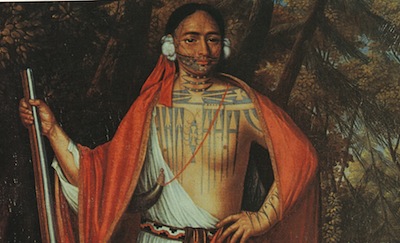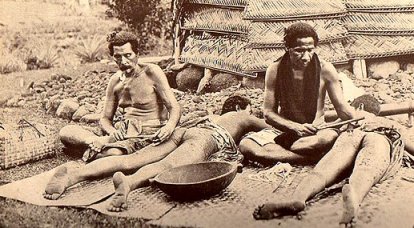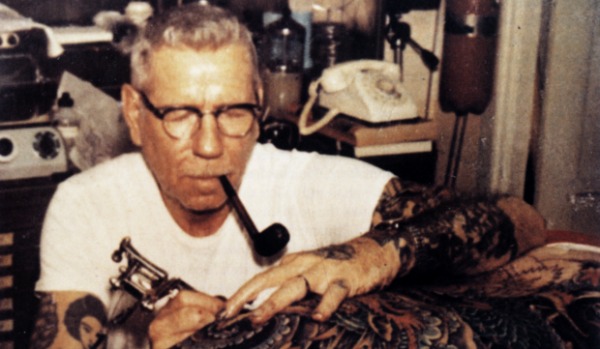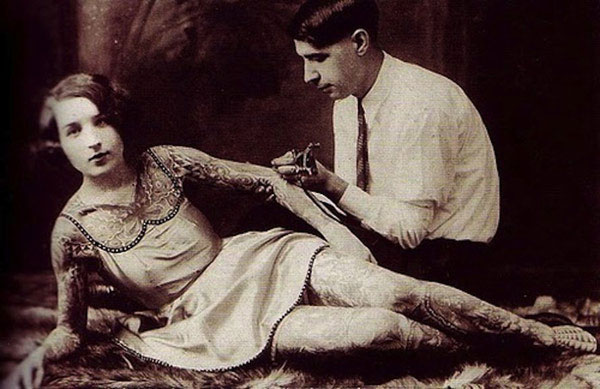

Evidence suggests that tattooing has been around since the Paleolithic era. Tattoos have been found on mummified beings, art, and talking about in ancient records. The oldest discovery of tattooed human skin to date is found on the body of Ötzi the Iceman, dating to between 3370 and 3100 BC. Other tattooed mummies have been sound in Greenland, Alaska, Siberia, Mongolia, western China, Egypt, Sudan, the Philippines, and the Andes.

In Southern India, permanent tattoos are called pachakutharathu. It was very common in south India, especially Tamil Nadu, before 1980. In northern India, permanent tattoos are called godna. Tattoos have been used as cultural symbols among many tribal populations, as well as the caste-based Hindu population of India. Henna is also used in India. Henna is a temporary ink used to create designs on the human skin that last about a week. This trend is still super popular today. In Egypt, most tattoos were found on women. Archeologists found that these tattoos were probably meant to serve as a medical practice to help in the healing of sickness and disease.
In ancient China, tattoos were seen as barbaric. If a person did have a tattoo, it was mainly because they were a prisoner and needed some type of identification. Slaves were also marked to display ownership. Many characters in southern Chinese folklore also possessed tattoos. In contrast, tattoos in ancient Japan were very common and popular amongst the population. Generally firemen, manual workers and prostitutes wore tattoos to communicate their status. However, prisoners and criminals, like in China, were also tattooed with indication that they were a criminal or with a derogatory slur.

In the Philippines, tattooing to some, was a form of rank and accomplishments, and some believed that tattoos had magical qualities. It was first document by European explorers, but was a tradition long before the documentation. The word tattoo is believed to have originated from the Samoan word tatau. In Samoa, the tradition of applying tattoo, or tatau, by hand has been unbroken for over two thousand years. Tools and techniques have hardly changed either. The skill is passed from father to son, each tattoo artist, learning the craft over many years of serving as his father's apprentice. A young artist-in-training often spent hours, and days, tapping designs into sand or tree bark using a special tattooing comb. Honoring their tradition, Samoan tattoo artists made this tool from sharpened boar's teeth fastened together with a portion of the turtle shell and to a wooden handle.
Traditional Samoan tattooing of the body is an ordeal not taken lightly. It takes many weeks to complete and the process is very painful. Tattooing was also a very costly procedure. It was not uncommon for half a dozen boys to be tattooed at the same time, requiring the services of four or more artists. It was not just the men who received tattoos, but the women too; their designs are of a much lighter nature rather than having the large areas of solid dye which are frequently seen in men’s tattoos. The tattooing of women was not nearly as ritualized like men’s were. Christian missionaries from the west attempted to purge tattooing among the Samoans, thinking it barbaric and inhumane. Many young Samoans resisted mission schools since they forbade them to wear tattoos. But over time attitudes relaxed toward this cultural tradition and tattooing began to reemerge in Samoan culture.
The earliest tattoo designs on European bodies are said to be as old as 40,000 years. These tattoos mainly involved long lines on the shoulder or legs. Pre-Christian Germanic, Celtic and other central and northern European tribes were often heavily tattooed, according to surviving accounts. During the gradual process of Christianization in Europe, tattoos were often considered remaining elements of paganism and generally legally prohibited. British and other pilgrims to the Holy Lands throughout the 17th century were tattooed to commemorate their voyages. Sailors also came back from exotic lands with tattoos to show their journeys. Doing this, sailors and seamen re-introduced the practice of tattooing in Europe and it spread rapidly to seaports around the globe. By the 19th century tattooing had however been practiced in an amateur way by public schoolboys from at least the 1840s and by the 1870s had become fashionable among some members of the upper classes, including royalty. Tattooing spread among the upper classes all over Europe in the 19th century. It is said many kings and other royals all sported tattoos, many of them elaborate and ornate renditions of the Royal Coat of Arms or the Royal Family Crest.
Despite this evidence, there is a myth that the upper and lower classes find tattooing attractive and the broader middle classes rejecting it. In 1969 the House of Lords debated a bill to ban the tattooing of minors, on grounds it had become "trendy" with the young in recent years but was associated with crime. It was noted that 40% of young criminals had tattoos and that marking the skin in this way tended to encourage self-identification with criminal groups. Two peers, Lord Teynham and the Marquess of Aberdeen and Temair however rose to object that they had been tattooed as youngsters, with no ill effects. Since the 1970s tattoos have become more socially acceptable, and fashionable among celebrities. Tattoos are less prominent on figures of authority, and the practice of tattooing by the elderly is still considered remarkable.
Like Europe, the first group of people who had tattoos was sailors. Using simple techniques and tools, tattoo artists in the early republic typically worked on board ships using anything available as pigments, even gunpowder and urine. Men marked their arms and hands with initials of themselves and loved ones, significant dates, symbols of the seafaring life, liberty poles, crucifixes, and other symbols. The first documented professional tattoo artist in the USA was Martin Hildebrandt from Massachusetts in 1846. Between 1861 and 1865, he tattooed soldiers on both sides in the American Civil War.

Since the 1970s, tattoos have become a mainstream part of global and Western fashion, common among both sexes, to all economic classes, and to age groups from the later teen years to middle age. For many young Americans, the tattoo has taken on a decidedly different meaning than for previous generations. The tattoo has "undergone dramatic redefinition" and has shifted from a form of deviance to an acceptable form of expression.
Tattoos have experienced a resurgence in popularity in many parts of the world, particularly in Europe, Japan, and North and South America. The growth in tattoo culture has seen an ride of new artists into the industry, many of whom have technical and fine arts training. This, combines with advancements in tattoo pigments and the ongoing refinement of the equipment used for tattooing, this has led to an improvement in the quality of tattoos being produced.
During the 2000s, the presence of tattoos became evident within pop culture, inspiring television shows such as A and E's Inked and TLC's Miami Ink and LA Ink. A current popular tattoo competition show called Ink Masters is on Spike. There are now various magazine publications and thousands of websites about tattoos. Formal interest in the art of the tattoo became prominent in the 1970s through the beginning of the 21st century. In addition, many celebrities have made tattoos more acceptable in recent years. Most cities all over the world also hold tattoo conventions where artists can show off their work, people can get tattooed. Also, new types of ink and tattoo equipetment are shown at these conventions.

Over the past three decades Western tattooing has become a practice that has crossed social boundaries from "low" to "high" class along with reshaping the power dynamics regarding gender. It has its roots in "exotic" tribal practices of the Native Americans and Japanese, which are still seen in present times. Although tattooing has steadily increased in popularity since the invention of the electric tattoo machine in the 1890s, it was not until the 1960s that the place of tattooing in popular culture radically shifted. The Tattoo Renaissance began in the late 1950s, and was greatly influenced by several artists, in particular Lyle Tuttle, Cliff Raven, Don Nolan, Zeke Owens, Spider Webb, and Don Ed Hardy. A second generation of artists, trained by the first, continued these traditions into the 1970s, and included artists such as Bob Roberts, Jamie Summers, and Jack Rudy. The people getting tattooed shifted from sailors, bikers, and gang members to the middle and upper class. There was also a shift in iconography from the badge-like images based on repetitive pre-made designs known as flash to customized full-body tattoo influenced by Polynesian and Japanese tattoo art, known as sleeves, which are categorized under the relatively new and popular Avant-garde genre.Tattooers transformed into "Tattoo Artists": men and women with fine art backgrounds began to enter the profession alongside the older, traditional tattooists.

The tattoo is one access point for revolutionary aesthetics of women. Feminist theory has much to say on the subject. "Bodies of Subversion: A Secret History of Women and Tattoo", by Margot Mifflin, became the first history of women's tattoo art when it was released in 1997. In it, she documents women's involvement in tattooing coinciding to feminist successes, with surges in the 1880s, 1920s, and the 1970s. The earliest appearance of tattoos on women were in the circus in the late 1800s. These "Tattooed Ladies" were covered - with the exception of their faces, hands, necks, and other readily visible areas - with various images inked into their skin. In order to lure the crowd, the earliest ladies, like Betty Broadbent and Nora Hildebrandt told tales of captivity; they usually claimed to have been taken hostage by Native Americans that tattooed them as a form of torture. However, by the late 1920s the sideshow industry was slowing and by the late 1990s the last tattooed lady was out of business.Today, women sometimes use tattoos as forms of bodily reclamations after traumatic experiences like abuse or breast cancer. In 2012, tattooed women outnumbered men for the first time in American history - according to a Harris poll, 23% of women in America had tattoos in that year, compared to 19% of men.